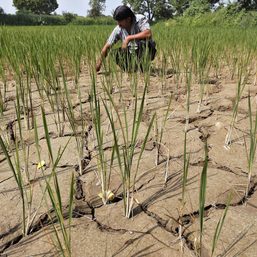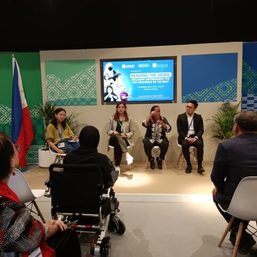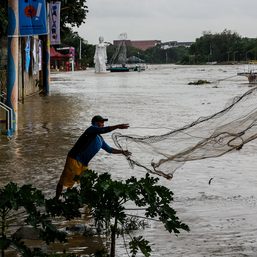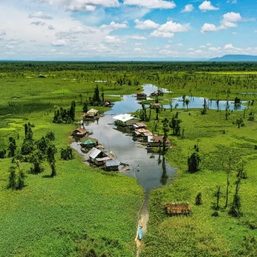SUMMARY
This is AI generated summarization, which may have errors. For context, always refer to the full article.
![[OPINION] On losing your home, livelihood, and more due to the climate crisis](https://www.rappler.com/tachyon/2022/07/tl-disaster-displacement.jpg)
As July is National Disaster Resilience Month, it serves as a timely reminder that the climate crisis is arguably the biggest threat to the Philippines’s pursuit of sustainable development. Given its many impacts, decision-makers must identify which issues associated with it should be prioritized and how to best use available resources. Two such issues are internal displacement and loss and damage, problems that are linked with one another.
There are many ways that human-induced climate change can force individuals and entire communities out of their homes and relocate within their country. Out of the 38 million internally displaced peoples (IDPs) worldwide last year, 23.7 million are due to disasters. Of this figure, 94% were caused by weather-related disasters such as storms and floods, another clear indicator of how climate change disrupts lives within communities and causes loss and damage.
It is no surprise that the Philippines, a nation exposed to multiple hazards, finds itself experiencing a high risk to climate-related loss and damage. High costs in terms of casualties and damage to properties and livelihoods have forced millions of Filipinos to abandon their homes at least temporarily and seek better conditions elsewhere.
A total of 5.7 million Filipinos were forced out of their homes last year due to disasters, more than any country except for China. By the end of 2021, the Philippines still has 700,000 internally displaced peoples due to disasters, nearly seven times as many as those displaced due to conflicts and violence. This includes the reported 590,000 displaced due to category 5 typhoon Odette, the second most destructive in the nation’s history.
However, sudden onset events like typhoons are not the only manifestation of the climate crisis that can lead to internal displacement and loss and damage. Slow onset events such as sea level rise and droughts occur more gradually, but if left unattended could cause more irreversible loss and damage for communities and ecosystems than sudden onset events.
For example, droughts in agricultural areas can lead to many adverse effects, including lower crop yields, loss of livelihoods, and lack of electricity for communities reliant on hydropower. These effects were observed in many parts of the Philippines during the El Niño-induced droughts of 2015-16, which placed the agricultural sector that was already one of the poorest in the country under even worse conditions.
Not only did farmers and their families endure economic loss and damage such as loss of agricultural production of more than P12 billion for the first half of 2016, they also experienced non-economic loss and damage, including impacts on physical and mental health, loss of ecosystem services due to land degradation, and even forced migration from extremely poor living conditions.
The issue of loss and damage primarily focuses on climate-related risks and impacts beyond the capacities of adaptation and reducing greenhouse gas emissions. Financing solutions to avoid or minimize it has become a hotly-debated topic in global negotiations, and should be a main part of the Philippine policy agenda on the climate crisis.
Whether through sudden or slow onset events, internal displacement can be triggered by loss and damage that is too much for the most vulnerable peoples to handle. If the needs of these individual and families are not adequately addressed in their new locations, they remain vulnerable to any calamity that could hit them, which could result in even more loss and damage.
Unfortunately, this cycle of injustice is just one of the many that is prevalent in the era of the climate emergency, especially in a country as high-risk as the Philippines. With climate change impacts projected to even worsen due to the failure to drastically cut down emissions in the following decades and the shortcomings of the Philippine government in properly assessing the extent of internal displacement, more Filipinos could be subjected to this ugly reality.
Policy recommendations
One of the biggest problems with addressing internal displacement is the difficulty in data collection and tracking the status of IDPs. Assessment tools used by government agencies need to be improved for specifically tracking those forced to migrate due to climate change impacts. These may include surveys on how climate-related factors influence their choice to relocate, standardizing procedures for data collection among local governments, and establishing a centralized database for internal displacement that provides inputs for policymaking.
Addressing internal displacement must become a bigger focus for climate governance in the Philippines. Heading into the November climate summit in Egypt, the government delegation may highlight responding to the needs of IDPs and avoiding further displacement as an extension of its calls for climate justice for developing countries and averting loss and damage.
At the national level, the incoming administration may include in its agenda enacting policies and laws that directly address issues associated with internal displacement. Following the outcomes of the recently-concluded climate inquiry of the Commission on Human Rights, these can focus on stronger protection of the human rights of victims of climate-related disasters and financial compensation for the loss and damage they endured.
This is also another strong argument against the creation of a Department of Disaster Resilience, as currently proposed in Congress. Avoiding more incidences of forced climate migration and subsequent economic and non-economic losses should always be prioritized over focusing on improving response after the disaster and displacement have already happened.
The theme of “no one is left behind” is in danger of losing its meaning. If we are to truly achieve climate justice and sustainable development, let us not forget responding to the needs of the most vulnerable, wherever they may be. – Rappler.com
John Leo Algo is the Deputy Executive Director of Programs and Campaigns of Living Laudato Si’ Philippines and a member of the interim Secretariat of Aksyon Klima Pilipinas. He has been representing Philippine civil society in regional and global UN conferences on climate and the environment since 2017. He has been a climate and environmental journalist since 2016.
Add a comment
How does this make you feel?
![[OPINION] Leaving no one behind: Internal displacement and the virus](https://www.rappler.com/tachyon/r3-assets/612F469A6EA84F6BAE882D2B94A4B421/img/6AD7A9D333F848669EB80B5D11753AC7/ispeak-bakwit.jpg?fit=449%2C360)
![[PODCAST] The Green Report: Climate change is a human rights issue. Now what?](https://www.rappler.com/tachyon/2022/05/The-Green-Report-TC.jpeg?fit=449%2C449)





There are no comments yet. Add your comment to start the conversation.